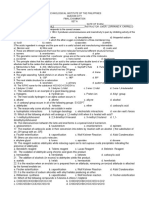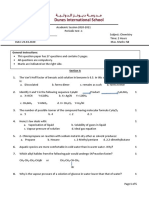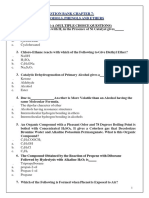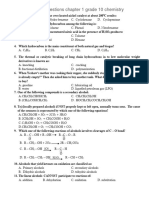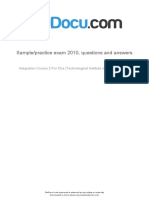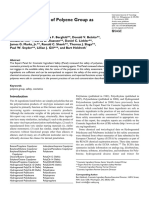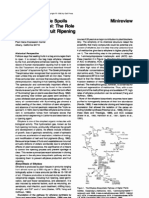0 ratings0% found this document useful (0 votes)
10 views12 - Aliphatic Hydrocarbons (PS)
12 - Aliphatic Hydrocarbons (PS)
Uploaded by
humaaot7Copyright:
© All Rights Reserved
Available Formats
Download as PDF, TXT or read online from Scribd
12 - Aliphatic Hydrocarbons (PS)
12 - Aliphatic Hydrocarbons (PS)
Uploaded by
humaaot70 ratings0% found this document useful (0 votes)
10 views8 pagesCopyright
© © All Rights Reserved
Available Formats
PDF, TXT or read online from Scribd
Share this document
Did you find this document useful?
Is this content inappropriate?
Copyright:
© All Rights Reserved
Available Formats
Download as PDF, TXT or read online from Scribd
Download as pdf or txt
0 ratings0% found this document useful (0 votes)
10 views8 pages12 - Aliphatic Hydrocarbons (PS)
12 - Aliphatic Hydrocarbons (PS)
Uploaded by
humaaot7Copyright:
© All Rights Reserved
Available Formats
Download as PDF, TXT or read online from Scribd
Download as pdf or txt
You are on page 1of 8
MathsflixByHashimZia PhysicsKaManjan ChemistryBySaadWaqar
CHEMISTRY ALIPHATIC HYDROCARBONS – PRACTICE SHEETS
PRACTICE SHEET # 01 (ALIPHATIC HYDROCARBONS - ALPHA)
1. Length in carbon-carbon bond is least in:
a. Ethane c. Ethene
b. Benzene d. Ethyne
2. Which of the following hydrocarbons is liquid at room temperature?
a. Butane c. Ethane
b. Hexane d. Ethene
3. Which of the following has the highest boiling point?
a. n-octane c. 2,2,3,3 - Tetramethylbutane
b. Iso-octane d. neo-octane
4. Which of the following is not formed by the reaction of 𝑪𝒍𝟐 on 𝑪𝑯𝟒 in sunlight?
a. 𝐶𝐻2 𝐶𝑙2 c. 𝐶𝐻3 𝐶𝑙
b. 𝐶𝐻3 𝐶𝑙 d. 𝐶𝐻3 𝐶𝐻2 𝐶𝐻3
5. Petroleum mainly contains
a. Aromatic hydrocarbons c. Aliphatic hydrocarbons
b. Aliphatic alcohol d. None of the above
6. Vicinal dihalides on treatment with zinc dust give:
a. Alkanes c. Alkynes
b. Alkenes d. All above
7. The reaction of alkenes with halogens is explosive in the case of:
a. 𝐹2 c. 𝐵𝑟2
b. 𝐶𝑙2 d. 𝐼2
8. Ethylene hydrogen sulphate is obtained by reaction of 𝑯𝟐 𝑺𝑶𝟒 with?
a. Ethane c. Ethyl chloride
b. Ethanal d. Ethylene
9. Alkynes can be reduced to alkenes by hydrogenation in presence of?
a. Pd c. Lindlar’s catalyst
b. Anhyd, 𝐴𝑙𝐶𝑙3 d. Raney Ni
10. Ethylene polymerization at 100 atm pressure and 𝟒𝟎𝟎𝟎 𝑪 gives:
a. Polybenzene c. Polyalcohol
b. Polypropylene d. Polyethene
11. Methane is used in:
a. In the preparation of hydrogen c. In the preparation chloroform
b. In the preparation of urea d. In all these preparations
12. Alkenes combine readily with electophile such as halogens giving:
a. Haloalkanes c. Alkylhalides
PREPARED AND COMPILED BY: ENGR. HAFIZ MUHAMMAD SAAD WAQAR
MathsflixByHashimZia PhysicsKaManjan ChemistryBySaadWaqar
CHEMISTRY ALIPHATIC HYDROCARBONS – PRACTICE SHEETS
b. Vicinal dihalides d. Vinyl halides
13. The elimination of HX from adjacent carbon atoms is called:
a. Halogenation c Hydroation
b. Dehydrohalogenation d Hydrohalogenation
14. When ethane is passed through a dilute solution of 𝐊𝐌𝐧𝐎𝟒 , pink color changes to:
a. Red c Green
b. Blue d Colorless
15. When reaction is used as test for presence of alkenes?
a. Combustion c. Polymerization
b. Reaction of soild dilute alkaline d. Catalytic hydrogenation
KMnO4
16. The process in which orbitals of different energies and shapes mix with each other
to give equivalent hybrid orbitals is called:
a. Isomeriztaion c. Hybridization
b. Polymeriztaion d. Resonance
17. Ethylene combines with water in the presence of 𝐇𝟐 𝐒𝐎𝟒 + 𝐇𝐠𝐒𝐎𝟒 and forms :
a. Ethylechrolide c. Eyhyle aclcohol
b. Carboxylic acid d. None of all
18. Ethyl hydrogen sulphate on hydrolysis with boiling water is converted to:
a. Methyl alcohol c. Ethylene
b. Propyl alcohol d. Ethyl alcohol
19. Paraffins are also called:
a. Alkanes c. Alkenes
b. Alkynes d. None of above
20. Hydrogenation of alkenes in presence of Ni as catalyst at 𝟑𝟎𝟎𝟎 𝑪 results in formation
of corresponding alkenes. This reaction is known as:
a. Sabatier-sendern reaction c. Kalbe’s reaction
b. Cannizaro’s reaction d. Haloform reaction
21. Which method is not used for the preparation of alkenes?
a. Dehydration of alcohol c. Dehalogenation of vic-dihalides
b. Dehydro halogenation of alkyl d. Halogination of alkanes
halide
22. Which of the following compound has the largest C-H bond?
a. Ethane c. Ethyne
b. Ethene d. Benzene
23. Which action will not give propene as a product?
a. Adding an excess of concentrated c. Passing 2- propanol vapor over heated
𝐻2 𝑆𝑂4 to I - Propanol aluminium oxide
PREPARED AND COMPILED BY: ENGR. HAFIZ MUHAMMAD SAAD WAQAR
MathsflixByHashimZia PhysicsKaManjan ChemistryBySaadWaqar
CHEMISTRY ALIPHATIC HYDROCARBONS – PRACTICE SHEETS
b. Adding warm aqueous NAOH to 2- d. Adding warm ethanolic NAOH to I-
bromopropane bromopropane
24. When bromine reacts with propene in an organic solvent at room temperature, what
is the mechanism by which bromine attacks propene?
a. Electrophilic addition c. Nucleophilic addition
b. Electrophilic substitution d. Nucleophilic substitution
25. Which reaction occurs when ethane and chlorine are mixed in diffused sunlight?
a. A nucleophilic addition c. A free-radical substitution
b. An Electrophilic addition d. A nucleophilic substitution
26. Hydrogen bromide reacts with ethane to form bromoethane. What is the best
description of the organic intermediate in this reaction?
a. It contains carbon, hydrogen, and c. It is an electrophile
bromine
b. It has a negative charge d. It is a free-radical
27. The reaction of chlorine with methane is carried out in the presence of light. What is
the function of light?
a. To break the C-H bond in methane c. To break up the chlorine molecules into
atoms
b. To break up the chlorine molecules d. To heat up the mixture
into ions
28. Light initiates the following reaction:
Alkane + Chlorine → Chloroalkane + Hydrogen Chloride
What happens to chlorine in this photochemical reaction?
a. Hytrolytic fission to give an c. Hytrolytic fission to give a free radical
electrophile
b. Homolytic fission to give d. Homolytic fission to give a free radical
electrophile
29. Hydrogen bromide reacts with ethane to form bromoethane.
What is the best description of the organic intermediate in this reaction?
a. It is a free radical c. It has an electrophile
b. It has a negative charge d. It contains carbon, hydrogen, and bromine
30. When bromine reacts with propene in organic solvent at room temperature, what is
the mechanism by which the bromine attacks the propene?
a. Electrophilic addition c. Nucleophilic addition
b. Electrophilic subsitution d. Nucleophilic subsitution
31. The aliphatic compounds include
a. Alkanes c. Alkynes
b. Alkene d. All of these
32. The unsaturated hydrocarbons include
PREPARED AND COMPILED BY: ENGR. HAFIZ MUHAMMAD SAAD WAQAR
MathsflixByHashimZia PhysicsKaManjan ChemistryBySaadWaqar
CHEMISTRY ALIPHATIC HYDROCARBONS – PRACTICE SHEETS
a. Alkene c. All of these
b. Alkynes d. Both a and b
33. A colorless gas with sweet smell produces anesthesia on in haltion is
a. Methene c. Ethane
b. Ethene d. CO
34. S(-CH2-CH2CI)2 is the formula for
a. Mustard gas c. Marsh gas
b. B,B- dichloro ethyl sulphide d. Both a and b
35. Ethyne when reacts with halogen acids it produces a
a. Geminal dihalide c. Isolated dihalide
b. vinical dihalide d. Ethene dihalide
36. The oxidation of ethyne with hot KMnO4 produces
a. Oxalic acid c. Acetic acid
b. Formic acid d. Both a and b
37. C4H6 formula may exist for different isomeric compound one of these isomer forms
a white solid with ammonical silver nitrate, this isomer is
a. CH3-C≡C-CH3 c. CH2=CH-CH=CH
b. CH3-CH2-C≡CH d. CH2=C=CH-CH2
38 The only hydrocarbons acidic in nature are
a. Terminal alkynes c. All alkenes
b. All alkynes d. Both a and b
39. Methane may be prepared from
a. CH3-I c. CH3-CH3
b. CH3COONa d. Both a and b
40. What is true about ethane?
a. It may be prepared from methyl c. Both of its carbons atoms are sp3 Hybridized
lodide by Wurtz reaction
b. It is saturated hydrocarbons d. All of these
PREPARED AND COMPILED BY: ENGR. HAFIZ MUHAMMAD SAAD WAQAR
MathsflixByHashimZia PhysicsKaManjan ChemistryBySaadWaqar
CHEMISTRY ALIPHATIC HYDROCARBONS – PRACTICE SHEETS
PRACTICE SHEET # 02 (ALIPHATIC HYDROCARBONS - BETA)
1. Alkanes containing a methyl group on main chain at 2nd carbon are called
a. iso-alkane c. neo-alkane
b. normal-alkane d. branched-alkane
2. Alkanes are also known as
a. saturated hydrocarbon c. paraffins
b. unsaturated hydrocarbon d. both a & c
3. Sabatier Senderns reaction involve _________ in presence of Ni
a. Alkene & H2 c. alkene & N2
b. alkene & O2 d. alkyne & Cl2
4. Hydrogenolysis results in the formation of
a. alkane c. alkyne
b. alkene d. aldehydes
5. Clemmensens reduction infolves the reduction of
a. Ketone c. Alkane
b. Aldehyde d. All of the above
6. Molozonide is unstable and changes into ozonide on
a. reduction c. hydrolysis
b. oxidation d. rearrangement
7. Which of the following is the most reactive
a. ethane c. ethene
b. ethyne d. benzene
8. Incomplete oxidation of methane in the limited supply of air forms.
a. CO2 and H2O c. CO + H2 + C
b. CH3OH d. CO + H2O + C
9. Order of ease of halogenation in alkane is
a. I2>Cl2>Br2>F2 c. F2>Cl2>Br2>I2
b. F2>Cl2>I2>Br2 d. Cl2>F2>Br2>I2
10. Which of the following will be acidic
a. propyne c. ethyne
b. 1-butyne d. all of the above
11. Removal of halogen and hydrogen atom is
a. halogenation c. dehydrohalogenation
b. dehalogenation d. hydrohalogenation
12. Raney nickel is prepared from __________ by treating with caustic soda
a. Ni-Cu alloy c. Ni-Al alloy
b. Ni-Fe alloy d. Ni-Mg alloy
PREPARED AND COMPILED BY: ENGR. HAFIZ MUHAMMAD SAAD WAQAR
MathsflixByHashimZia PhysicsKaManjan ChemistryBySaadWaqar
CHEMISTRY ALIPHATIC HYDROCARBONS – PRACTICE SHEETS
13. Which is used for artificial ripening of fruit?
a. ethane c. ethyne
b. ethene d. methane
14. Ethene is used in the artificial ripening of:
a. Oranges c. Cherrys
b. Lemons d. All of these
15. Beta,Beta -dichloroethylsulphide is commonly known as
a. laughing gas c. mustard gas
b. bio-gas d. phosgene gas
16. _______________ is prepared on a small scale in the laboratory by heating together ethyl
alcohol and sulphuric acid:
a. methane c. Ethylene
b. ethane d. None of these
17. When methyl iodide is treated with ________________, ethane is formed:
a. Sodium metal c. molecular hydrogen (H2)
b. Nascent hydrogen [H] d. Molecular oxygen (O2)
18. Pure ethane is obtained by _______________ of ethyl magnesium iodide:
a. Reduction c. Oxidation
b. Hydrolysis d. Halogenations
19. When vicinal dichloroethane is treated with _________________ powder it loses one
molecule of halogen and forms ethane:
a. Sodium metal c. Copper metal
b. Iron metal d. Zinc metal
20. Ethene:
a. Is a colourless gas with sweet smell c. Is less denser than air
b. Is sparingly soluble in water but d. All of these
soluble in organic solvent like alcohol
and ether
21. Paraffins are:
a. Gasses c. Liquids
b. Solids d. All of these
22. To bring about chemical change in alkane we need:
a. High temperature c. Both of these
b. Strong electrophilic reagent d. None of these
23. The less reactivity of CH4 is associated with its:
a. Covalent bond c. None polar nature
b. Ionic bond d. All of these
24. When hydrocarbon is ignited in the presence of excess of air, it burns produces
a. CO2 c. CO3−2
b. CO d. HCO−1 3
PREPARED AND COMPILED BY: ENGR. HAFIZ MUHAMMAD SAAD WAQAR
MathsflixByHashimZia PhysicsKaManjan ChemistryBySaadWaqar
CHEMISTRY ALIPHATIC HYDROCARBONS – PRACTICE SHEETS
25. CH4 reacts with Cl2 in a dark produces:
a. HCl c. CH3 – Cl
b. Carbon black d. Doesnot react
26. In CaC2 the oxidation number of C is:
a. +4 c. – 1
b. – 4 d. – 2
27. Which halogen doesn’t react with CH4 in the presence of diffused sunlight?
a. Cl2 c. I2
b. Br2 d. F2
28. The nitration of propane is a type of:
a. Addition reaction c. Hydrolysis reaction
b. Substitution reaction d. Pyrolysis reaction
29. The second largest component of natural gas is:
a. Methane c. Ethane
b. Propane d. Butane
30. The Empirical formula of butanoic acid is:
a. C4H6O2 c. CH2O
b. C2H4O d. C2H2O
31. Which property is common among the following compounds CH4, C2H5Cl, C6H6 AND
CH3 – CH3 :
a. All are hydrocarbons c. All can undergo substitution reaction
b. All can undergo addition reaction d. All can undergo polymerization
32. Baeyers test is used to detect:
a. Unsaturation in organic compounds c. Hydrogen in organic compounds
b. Carbon in organic compounds d. H2O in organic compounds
33. Butane – di – oic acid on neutralization with sodium hydroxide produces:
a. Sodium succinate c. Succinic acid
b. Di – sodium succinate d. Butane – di - ol
34. Cyclobutane is an example of:
a. Aromatic hydrocarbon c. Alicyclic hydrocarbon
b. Aliphatic hydrocarbon d. Heterocyclic hydrocarbon
35. 1 mole of which of the following on combustion produces large amount of heat:
a. CH4 c. C3H8
b. C2H6 d. C4H10
36. Margarine is produced from vegetable and animals oils through:
a. Markownikkoffs reaction c. Sabatier sendern’s reaction
b. Nuclcophilic substitution reaction d. Fridal crafts reaction
37. The order of reactivity of halogen acids towards hydrocarbons:
a. HBr>HI>HCI. c. HI>HBr>HCI.
b. HCI>HBr>HI d. None
PREPARED AND COMPILED BY: ENGR. HAFIZ MUHAMMAD SAAD WAQAR
MathsflixByHashimZia PhysicsKaManjan ChemistryBySaadWaqar
CHEMISTRY ALIPHATIC HYDROCARBONS – PRACTICE SHEETS
38. The double bond in alkenes behaves as:
a. Nucleophilic reagent c. Lewis acid
b. Electrophilic reagent d. Electron pair acceptor
PRACTICE SHEET # 01 (ALIPHATIC HYDROCARBONS - ALPHA)
ANSWER KEY
Question Option Question Option Question Option Question Option
1. d. 11. c. 21. d. 31. d.
2. b. 12. b. 22. a. 32. d.
3. a. 13. b. 23. b. 33. b.
4. d. 14. d. 24. a. 34. d.
5. c. 15. b. 25. c. 35. a.
6. b. 16. c. 26. d. 36. a.
7. a. 17. c. 27. c. 37. b.
8. d. 18. d. 28. d. 38. a.
9. c. 19. a. 29. c. 39. d.
10. d. 20. a. 30. a. 40. d.
PRACTICE SHEET # 02 (ALIPHATIC HYDROCARBONS - BETA)
ANSWER KEY
Question Option Question Option Question Option Question Option
1. a. 11. c. 21. d. 31. c.
2. d. 12. c. 22. c. 32. d.
3. a. 13. b. 23. c. 33. b.
4. a. 14. d. 24. a. 34. c.
5. a. 15. c. 25. d. 35. d.
6. d. 16. c. 26. c. 36. c.
7. c. 17. a. 27. c. 37. c.
8. d. 18. b. 28. b. 38. a.
9. c. 19. d. 29. c.
10. d. 20. d. 30. b.
PREPARED AND COMPILED BY: ENGR. HAFIZ MUHAMMAD SAAD WAQAR
You might also like
- Chemical Compatibility GuideDocument41 pagesChemical Compatibility Guidetpcho100% (1)
- Competency Exam in Organic ChemistryDocument4 pagesCompetency Exam in Organic ChemistryRaymond Yabut100% (1)
- Competency Exam in Organic ChemistryDocument3 pagesCompetency Exam in Organic ChemistryWinsletJoyDauagNo ratings yet
- SS3 First Term Chemistry ExamDocument8 pagesSS3 First Term Chemistry ExammayowaednutNo ratings yet
- 12 - TPP - Aliphatic HydrocarbonsDocument2 pages12 - TPP - Aliphatic HydrocarbonsSaadia AsgharNo ratings yet
- Organic ChemistryDocument36 pagesOrganic ChemistryPepy PeachNo ratings yet
- ORGANIC ACT 3_EXAMDocument4 pagesORGANIC ACT 3_EXAMMary Mae VitorNo ratings yet
- 891723542098115-Gr10ChemOrganicChemistry202425AKDocument5 pages891723542098115-Gr10ChemOrganicChemistry202425AKaditi291128No ratings yet
- Hydrobarbon Exam ElmosoaaDocument9 pagesHydrobarbon Exam ElmosoaaahesekyNo ratings yet
- Review Questions and ProblemsDocument6 pagesReview Questions and Problemsmache dumadNo ratings yet
- MDCAT 2022 HydrocarbonsDocument41 pagesMDCAT 2022 Hydrocarbonszaka ullahNo ratings yet
- Halogen Derivative WorksheetDocument5 pagesHalogen Derivative WorksheetdivyabadhoutiaNo ratings yet
- Organic ChemistryDocument2 pagesOrganic ChemistryKim SeungminNo ratings yet
- TEST-7 ELITE (C-7&8)Document2 pagesTEST-7 ELITE (C-7&8)tarunmathur7777No ratings yet
- Org Part 1 With AnsDocument7 pagesOrg Part 1 With AnsDeepak PradhanNo ratings yet
- Test Aldehydes and KetonesDocument3 pagesTest Aldehydes and Ketonestanmay.sachdeva123No ratings yet
- Org 2Document9 pagesOrg 2Chandan SahuNo ratings yet
- Test 1Document9 pagesTest 1Julie Anne CristalesNo ratings yet
- Module 1 3Document9 pagesModule 1 3Alkiana SalardaNo ratings yet
- Chem. Model OneDocument11 pagesChem. Model OneNimonaNo ratings yet
- 04 Chemistry Unit-10 (Student Copy)Document4 pages04 Chemistry Unit-10 (Student Copy)Kamran ShabbirNo ratings yet
- Unit 8,9 and 10 Worksheet - QUESTION BANK GR 12Document25 pagesUnit 8,9 and 10 Worksheet - QUESTION BANK GR 12Tvisha MalikNo ratings yet
- Board Reviewer in PhyChePriDocument13 pagesBoard Reviewer in PhyChePriWinsletJoyDauagNo ratings yet
- cemical properties of alkanes 2 pdfDocument6 pagescemical properties of alkanes 2 pdfvelammal kolapakkamNo ratings yet
- (Chem 31) LE2 Samplex + AnsKey (1-1920)Document10 pages(Chem 31) LE2 Samplex + AnsKey (1-1920)Glyzen GaleonNo ratings yet
- 8 - QP - Aldehyde Ketone Carboxylic AcidDocument8 pages8 - QP - Aldehyde Ketone Carboxylic AcidJems Chaudhary100% (1)
- XII Chemistry Chapter 08 2Document10 pagesXII Chemistry Chapter 08 2aqsa15873No ratings yet
- D0597551 CHEM12 C2300 CTBS MigDocument5 pagesD0597551 CHEM12 C2300 CTBS MigHitman KillerNo ratings yet
- 12 - TPP Aldehydes and KetonesDocument9 pages12 - TPP Aldehydes and KetonesSaadia AsgharNo ratings yet
- 8 - QP - Aldehyde Ketone Carboxylic AcidDocument8 pages8 - QP - Aldehyde Ketone Carboxylic Acidpriyanshu dwivediNo ratings yet
- Toprank Preboard Exam Module 1 PHLE 2024Document10 pagesToprank Preboard Exam Module 1 PHLE 2024Mikka Joy ValenciaNo ratings yet
- Hydrocarbon 1Document6 pagesHydrocarbon 1VK CREATIONNo ratings yet
- Lec. 2Document46 pagesLec. 2Abdullah AmjadNo ratings yet
- Organic Mock Exam QuestionsDocument119 pagesOrganic Mock Exam QuestionsAriel Raye Rica100% (1)
- Sample Questions For S.Y.B.Pharm Sem III CBCS R 2019 OC II ATKT ExamsDocument4 pagesSample Questions For S.Y.B.Pharm Sem III CBCS R 2019 OC II ATKT Examsshrutinavrang29No ratings yet
- Aldehyde-and-ketone-2081 (1)Document3 pagesAldehyde-and-ketone-2081 (1)kabitlove4familyNo ratings yet
- Unit 11 - Alcohols, Phenols & Ethers - MCQDocument5 pagesUnit 11 - Alcohols, Phenols & Ethers - MCQalisha iqbalNo ratings yet
- Grade 12 Chemistry PT1 2020-21Document5 pagesGrade 12 Chemistry PT1 2020-21Sudha BhatNo ratings yet
- Aldehydes Ketones and Carboxylic Acid AssignmentDocument3 pagesAldehydes Ketones and Carboxylic Acid Assignmenthethinsu1No ratings yet
- ALCOHOLS, PHENOLS & ETHERS QuesDocument12 pagesALCOHOLS, PHENOLS & ETHERS Quesaryaveer376No ratings yet
- QUESTION BANK 1 CLASS 12TH ORGANIC CHEMISTRYDocument3 pagesQUESTION BANK 1 CLASS 12TH ORGANIC CHEMISTRYelduro26No ratings yet
- Grade 10 ChemDocument6 pagesGrade 10 ChemDegu DegaregNo ratings yet
- SSS 3 Second Term ExaminationDocument7 pagesSSS 3 Second Term Examinationmayowaednut100% (1)
- Tick The Correct Option.: Chemistry Entry Test MCAT By: Sagheer Ahmad Gudara M.Phill ChemistryDocument4 pagesTick The Correct Option.: Chemistry Entry Test MCAT By: Sagheer Ahmad Gudara M.Phill ChemistrykamranNo ratings yet
- DUHS Mdcat TestDocument7 pagesDUHS Mdcat Testkcmzppyc9gNo ratings yet
- Chemistry Sample Paper 2021-22Document9 pagesChemistry Sample Paper 2021-22arpita1835No ratings yet
- Sample/practice Exam 2010, Questions and Answers Sample/practice Exam 2010, Questions and AnswersDocument14 pagesSample/practice Exam 2010, Questions and Answers Sample/practice Exam 2010, Questions and AnswersEilyza Aballa100% (1)
- Haloalkane Imp QurstionsDocument4 pagesHaloalkane Imp QurstionsMohit BistaNo ratings yet
- SCH3U - Practice ExamDocument9 pagesSCH3U - Practice ExamWaqas AhmadNo ratings yet
- 10th CHMDocument1 page10th CHMzeeshanhameedz1996No ratings yet
- Lec 2 RevisionDocument3 pagesLec 2 RevisionadhamelthnNo ratings yet
- (MSU SASE) Chemistry-1Document4 pages(MSU SASE) Chemistry-1Arice MontiponNo ratings yet
- 12th Che Revision 1Document6 pages12th Che Revision 1naga06557No ratings yet
- Pharm Chem For CPH 1.1Document5 pagesPharm Chem For CPH 1.1nalwangacarol381No ratings yet
- 100 MCQS on AminesDocument16 pages100 MCQS on Aminesnofb0155No ratings yet
- Chapter No. 18 Alcohols Phenols & Ethers McqsDocument2 pagesChapter No. 18 Alcohols Phenols & Ethers McqsAbdul Qayyum100% (1)
- CHEM 132 QUESTIONS - 3Document5 pagesCHEM 132 QUESTIONS - 3Amina bello KokoNo ratings yet
- ALDEHYDES Ketones Carboxylic AcidDocument10 pagesALDEHYDES Ketones Carboxylic Acidmohithraganesan07No ratings yet
- 12.Mcq - Aldehydes Ketones Carboxylic AcidsDocument23 pages12.Mcq - Aldehydes Ketones Carboxylic AcidsBedosi Bidita PandaNo ratings yet
- Practice Makes Perfect in Chemistry: Organic ChemistryFrom EverandPractice Makes Perfect in Chemistry: Organic ChemistryRating: 3 out of 5 stars3/5 (1)
- 2.0 Design of Hydrogenation Reactor 2.1 Process DescriptionDocument10 pages2.0 Design of Hydrogenation Reactor 2.1 Process DescriptionMuhyuddin ArshadNo ratings yet
- V.A. Index of Third and Fourth Edition Method Numbers: P-ChlorobenzotrifluorideDocument7 pagesV.A. Index of Third and Fourth Edition Method Numbers: P-ChlorobenzotrifluorideLuis Felipe Mera GrandasNo ratings yet
- Data For Oil Used in TransformerDocument31 pagesData For Oil Used in TransformerPlanning EngineeringNo ratings yet
- Jurnal Internasional FisiologiDocument4 pagesJurnal Internasional FisiologiNURMITRA EKA SAPUTRINo ratings yet
- Test Series For Neet-2020Document16 pagesTest Series For Neet-2020kavyareddyNo ratings yet
- Chem 211 Organic Chemistry IDocument65 pagesChem 211 Organic Chemistry Imrssadis66No ratings yet
- CHM 313Document37 pagesCHM 313Babalola AyokunuNo ratings yet
- (Thermoplastic Polymer) - EP2432830B1Document23 pages(Thermoplastic Polymer) - EP2432830B1annisa latifaNo ratings yet
- Org ShortDocument22 pagesOrg ShortbabyNo ratings yet
- Polymers - Library ContentDocument141 pagesPolymers - Library ContentCH M RehanNo ratings yet
- Hydrogenated PolysobuteneDocument32 pagesHydrogenated PolysobuteneinfoptgloriglobalsuksesNo ratings yet
- Yue 2012 Ethyleneglycol ProDocument29 pagesYue 2012 Ethyleneglycol ProMark Lawrence MagsombolNo ratings yet
- 25 01 2023 Chemistry - Paper+With+Answer - EveningDocument9 pages25 01 2023 Chemistry - Paper+With+Answer - EveningLanaNo ratings yet
- Short Notes On PolymerizationDocument6 pagesShort Notes On PolymerizationMohammed AshroffNo ratings yet
- Cheng 323 Chap 4Document82 pagesCheng 323 Chap 4Faisal Mumtaz100% (2)
- Banana Ripening: Principles and PracticeDocument79 pagesBanana Ripening: Principles and PracticeZafar IqbalNo ratings yet
- DGADocument20 pagesDGArasheed313No ratings yet
- UntitledDocument1 pageUntitledamitiffco0% (1)
- 22315-2023-Winter-Question-Paper (Msbte Study Resources)Document4 pages22315-2023-Winter-Question-Paper (Msbte Study Resources)hollowpurple156No ratings yet
- Derakane Resin Chemical ResistantDocument50 pagesDerakane Resin Chemical ResistantTim KuNo ratings yet
- Understanding DGA Techniques InterpretationsDocument46 pagesUnderstanding DGA Techniques InterpretationsKushal SinghNo ratings yet
- Alkanes and Alkenes NotesDocument4 pagesAlkanes and Alkenes Notessohaila ibrahimNo ratings yet
- ) Iupac (International Union of Pure and Applied Chemistry) - Is Used To Name OrganicDocument11 pages) Iupac (International Union of Pure and Applied Chemistry) - Is Used To Name OrganicPkrajen PillaiNo ratings yet
- Fruit RipeningDocument4 pagesFruit RipeningKartikeya YadavNo ratings yet
- ChemistryDocument39 pagesChemistrysafaalananyNo ratings yet
- 201105151926340.nexant Industry Report 2011Document40 pages201105151926340.nexant Industry Report 2011yudhie_7No ratings yet
- Coal To Olefins & Methanol To Olefins: Chemical Process Technology. Professor:-Dr. Pravin KodgireDocument29 pagesCoal To Olefins & Methanol To Olefins: Chemical Process Technology. Professor:-Dr. Pravin KodgireMicrosoft GamingNo ratings yet
- 1st Term s3 ChemistryDocument42 pages1st Term s3 ChemistrykindneysamNo ratings yet
- 21 CFR 178.3570 (Up To Date As of 10-31-2023)Document5 pages21 CFR 178.3570 (Up To Date As of 10-31-2023)padungekNo ratings yet


